Long-Term Petroleum Hydrocarbons Pollution after a Coastal Oil Spill
Abstract
:1. Introduction
2. Materials and Methods
2.1. Study Area and Sample Collection
2.2. Analytical Method
3. Results and Discussions
3.1. PHs in Seawater
3.2. PHs in Sediment
3.3. PHs Temporal Trends
4. Conclusions
Author Contributions
Funding
Institutional Review Board Statement
Informed Consent Statement
Data Availability Statement
Acknowledgments
Conflicts of Interest
References
- Xu, H.L.; Chen, J.N.; Wang, S.D.; Liu, Y. Oil spill forecast model based on uncertainty analysis: A case study of Dalian oil spill. Ocean Eng. 2012, 54, 206–212. [Google Scholar] [CrossRef]
- Guo, W.; Hao, Y.; Zhang, L.; Xu, T.; Ren, X.; Cao, F.; Wang, S. Development and application of an oil spill model with wave–current interactions in coastal areas. Mar. Pollut. Bull. 2014, 84, 213–224. [Google Scholar] [CrossRef]
- Yu, X.; Zhang, W.; Liu, X.; Lei, J.; Lin, Z.; Yao, Z.; Yao, X.; Jin, X.; Yang, H.; Huang, H. The distribution of and biodegradation impact on spilled oil in sediments from Dalian Bay, NE China. Mar. Pollut. Bull. 2018, 135, 1007–1015. [Google Scholar] [CrossRef] [PubMed]
- Keramea, P.; Spanoudaki, K.; Zodiatis, G.; Gikas, G.; Sylaios, G. Oil spill modeling: A critical review on current trends, perspectives, and challenges. J. Mar. Sci. Eng. 2021, 9, 181. [Google Scholar] [CrossRef]
- Câmara, S.F.; Pinto, F.R.; da Silva, F.R.; de Oliveira Soares, M.; De Paula, T.M. Socioeconomic vulnerability of communities on the Brazilian coast to the largest oil spill (2019–2020) in tropical oceans. Ocean Coast. Manag. 2021, 202, 105506. [Google Scholar] [CrossRef]
- Liu, X.; Jia, H.; Wang, L.; Qi, H.; Ma, W.; Hong, W.; Guo, J.; Yang, M.; Sun, Y.; Li, Y.F. Characterization of polycyclic aromatic hydrocarbons in concurrently monitored surface seawater and sediment along Dalian coast after oil spill. Ecotox. Environ. Saf. 2013, 90, 151–156. [Google Scholar] [CrossRef]
- Zhang, D.; Ding, A.; Cui, S.; Hu, C.; Thornton, S.F.; Dou, J.; Sun, Y.; Huang, W.E. Whole cell bioreporter application for rapid detection and evaluation of crude oil spill in seawater caused by Dalian oil tank explosion. Water Res. 2013, 47, 1191–1200. [Google Scholar] [CrossRef]
- Fernandes, G.M.; Martins, D.A.; Santos, R.P.; Santiago, I.S.; Nascimento, L.S.; Oliveira, A.H.; Yamamoto, F.Y.; Cavalcante, R.M. Levels, source appointment, and ecological risk of petroleum hydrocarbons in tropical coastal ecosystems (northeast Brazil): Baseline for future monitoring programmes of an oil spill area. Environ. Pollut. 2021, 296, 118709. [Google Scholar] [CrossRef]
- Duan, J.; Liu, W.; Zhao, X.; Han, Y.; O’Reilly, S.E.; Zhao, D. Study of residual oil in Bay Jimmy sediment 5 years after the Deepwater Horizon oil spill: Persistence of sediment retained oil hydrocarbons and effect of dispersants on desorption. Sci. Total Environ. 2018, 618, 1244–1253. [Google Scholar] [CrossRef]
- Burns, K.A.; Garrity, S.D.; Jorissen, D.; MacPherson, J.; Stoelting, M.; Tierney, J.; Yelle-Simmons, L. The Galeta oil spill. II. Unexpected persistence of oil trapped in mangrove sediments. Estuar. Coast. Shelf Sci. 1994, 38, 349–364. [Google Scholar] [CrossRef]
- Wang, Z.; Fingas, M.; Blenkinsopp, S.; Sergy, G.; Landriault, M.; Sigouin, L.; Lambert, P. Study of the 25-year-old Nipisi oil spill: Persistence of oil residues and comparisons between surface and subsurface sediments. Environ. Sci. Technol. 1998, 32, 2222–2232. [Google Scholar] [CrossRef]
- Gu, Y.; You, Y.; Thrush, S.; Brustolin, M.; Liu, Y.; Tian, S.; Ye, J.; Jia, H.; Liu, G. Responses of the macrobenthic community to the Dalian Bay oil spill based on co-occurrence patterns and interaction networks. Mar. Pollut. Bull. 2021, 171, 112662. [Google Scholar] [CrossRef] [PubMed]
- Arekhi, M.; Terry, L.G.; John, G.F.; Clement, T.P. Environmental fate of petroleum biomarkers in Deepwater Horizon oil spill residues over the past 10 years. Sci. Total Environ. 2021, 791, 148056. [Google Scholar] [CrossRef] [PubMed]
- SBQTS. The Specification for Marine Monitoring Part 4: Sea Water Analysis (GB 17378.4-2007); State Bureau of Quality and Technical Supervision Standards Press of China: Beijing, China, 2008. [Google Scholar]
- Guo, L.; Su, J.J.F.; Chang, Y.; Shi, Y.; Yao, Z.; Ma, Y.; Guan, D.; Fan, J. Study on the petroleum hydrocarbon degradation and the change of bacterial abundance within 5 years after Dalian "7.16" oil spill accident. Mar. Sci. Bull 2017, 36, 311–319. (In Chinese) [Google Scholar]
- Huang, M.; Liu, Y.; Xing, X.; Wang, Z.; Li, Z. Analysis of temporal and spatial variation in petroleum content in sea waters at Dalian port. J. Dalian Ocean Univ 2020, 35, 273–279. (In Chinese) [Google Scholar]
- Lee, K. Oil–particle interactions in aquatic environments: Influence on the transport, fate, effect and remediation of oil spills. Spill Sci. Technol. Bull. 2002, 8, 3–8. [Google Scholar] [CrossRef]
- Diercks, A.R.; Romero, I.C.; Larson, R.A.; Schwing, P.; Harris, A.; Bosman, S.; Chanton, J.P.; Brooks, G. Resuspension, redistribution, and deposition of oil-residues to offshore depocenters after the Deepwater Horizon oil spill. Front. Mar. Sci. 2021, 8, 737. [Google Scholar] [CrossRef]
- Olson, G.M.; Meyer, B.M.; Portier, R.J. Assessment of the toxic potential of polycyclic aromatic hydrocarbons (PAHs) affecting Gulf menhaden (Brevoortia patronus) harvested from waters impacted by the BP Deepwater Horizon Spill. Chemosphere 2016, 145, 322–328. [Google Scholar] [CrossRef]
- Hinga, K.R. Degradation rates of low molecular weight PAH correlate with sediment TOC in marine subtidal sediments. Mar. Pollut. Bull. 2003, 46, 466–474. [Google Scholar] [CrossRef]
- ASCE Task Committee. State-of-the-art review of modeling transport and fate of oil spills. J. Hydraul. Eng. 1996, 122, 594–609. [Google Scholar] [CrossRef]
- Gong, Y.; Zhao, X.; Cai, Z.; O’reilly, S.E.; Hao, X.; Zhao, D. A review of oil, dispersed oil and sediment interactions in the aquatic environment: Influence on the fate, transport and remediation of oil spills. Mar. Pollut. Bull. 2014, 79, 16–33. [Google Scholar] [CrossRef] [PubMed]
- Sterling, M.C., Jr.; Bonner, J.S.; Ernest, A.N.; Page, C.A.; Autenrieth, R.L. Application of fractal flocculation and vertical transport model to aquatic sol–sediment systems. Water Res. 2005, 39, 1818–1830. [Google Scholar] [CrossRef] [PubMed]
- Owens, E.H.; Lee, K. Interaction of oil and mineral fines on shorelines: Review and assessment. Mar. Pollut. Bull. 2003, 47, 397–405. [Google Scholar] [CrossRef]
- Guo, W.; Wu, G.; Jiang, M.; Xu, T.; Yang, Z.; Xie, M.; Chen, X. A modified probabilistic oil spill model and its application to the Dalian New Port accident. Ocean. Eng. 2016, 121, 291–300. [Google Scholar] [CrossRef]
- Li, Y.; Cao, R.; Chen, H.; Mu, L.; Lv, X. Impact of oil−sediment interaction on transport of underwater spilled oil in the Bohai Sea. Ocean Eng. 2022, 247, 110687. [Google Scholar] [CrossRef]
- Alves, T.M.; Kokinou, E.; Zodiatis, G. A three-step model to assess shoreline and offshore susceptibility to oil spills: The South Aegean (Crete) as an analogue for confined marine basins. Mar. Pollut. Bull. 2014, 86, 443–457. [Google Scholar] [CrossRef]
- Alves, T.M.; Kokinou, E.; Zodiatis, G.; Lardner, R.; Panagiotakis, C.; Radhakrishnan, H. Modelling of oil spills in confined maritime basins: The case for early response in the Eastern Mediterranean Sea. Environ. Pollut. 2015, 206, 390–399. [Google Scholar] [CrossRef]
- Alves, T.M.; Kokinou, E.; Zodiatis, G.; Radhakrishnan, H.; Panagiotakis, C.; Lardner, R. Multidisciplinary oil spill modeling to protect coastal communities and the environment of the Eastern Mediterranean Sea. Sci. Rep. 2016, 6, 36882. [Google Scholar] [CrossRef]
- Kingston, P.F. Long-term environmental impact of oil spills. Spill Sci. Technol. Bull. 2002, 7, 53–61. [Google Scholar] [CrossRef]
- Yan, B.; Passow, U.; Chanton, J.P.; Nöthig, E.-M.; Asper, V.; Sweet, J.; Pitiranggon, M.; Diercks, A.; Pak, D. Sustained deposition of contaminants from the Deepwater Horizon spill. Proc. Natl. Acad. Sci. USA 2016, 113, E3332–E3340. [Google Scholar] [CrossRef]
- Shu, Y.; Wang, X.; Huang, Z.; Song, L.; Fei, Z.; Gan, L.; Xu, Y.; Yin, J. Estimating spatiotemporal distribution of wastewater generated by ships in coastal areas. Ocean Coast. Manag. 2022, 222, 106133. [Google Scholar] [CrossRef]
- Hermansson, A.L.; Hassellöv, I.M.; Moldanová, J.; Ytreberg, E. Comparing emissions of polyaromatic hydrocarbons and metals from marine fuels and scrubbers. Transp. Res. Part D Transp. Environ. 2021, 97, 102912. [Google Scholar] [CrossRef]
- Bandara, U.C.; Yapa, P.D.; Xie, H. Fate and transport of oil in sediment laden marine waters. J. Hydro-Environ. Res. 2011, 5, 145–156. [Google Scholar] [CrossRef]
- Bagby, S.C.; Reddy, C.M.; Aeppli, C.; Fisher, G.B.; Valentine, D.L. Persistence and biodegradation of oil at the ocean floor following Deepwater horizon. Proc. Natl. Acad. Sci. USA 2017, 114, E9–E18. [Google Scholar] [CrossRef]
- Guo, W.; Wu, G.; Xu, T.; Li, X.; Ren, X.; Hao, Y. Numerical modelling of temporal and spatial patterns of petroleum hydrocarbons concentration in the Bohai Sea. Mar. Pollut. Bull. 2018, 127, 251–263. [Google Scholar] [CrossRef] [PubMed]
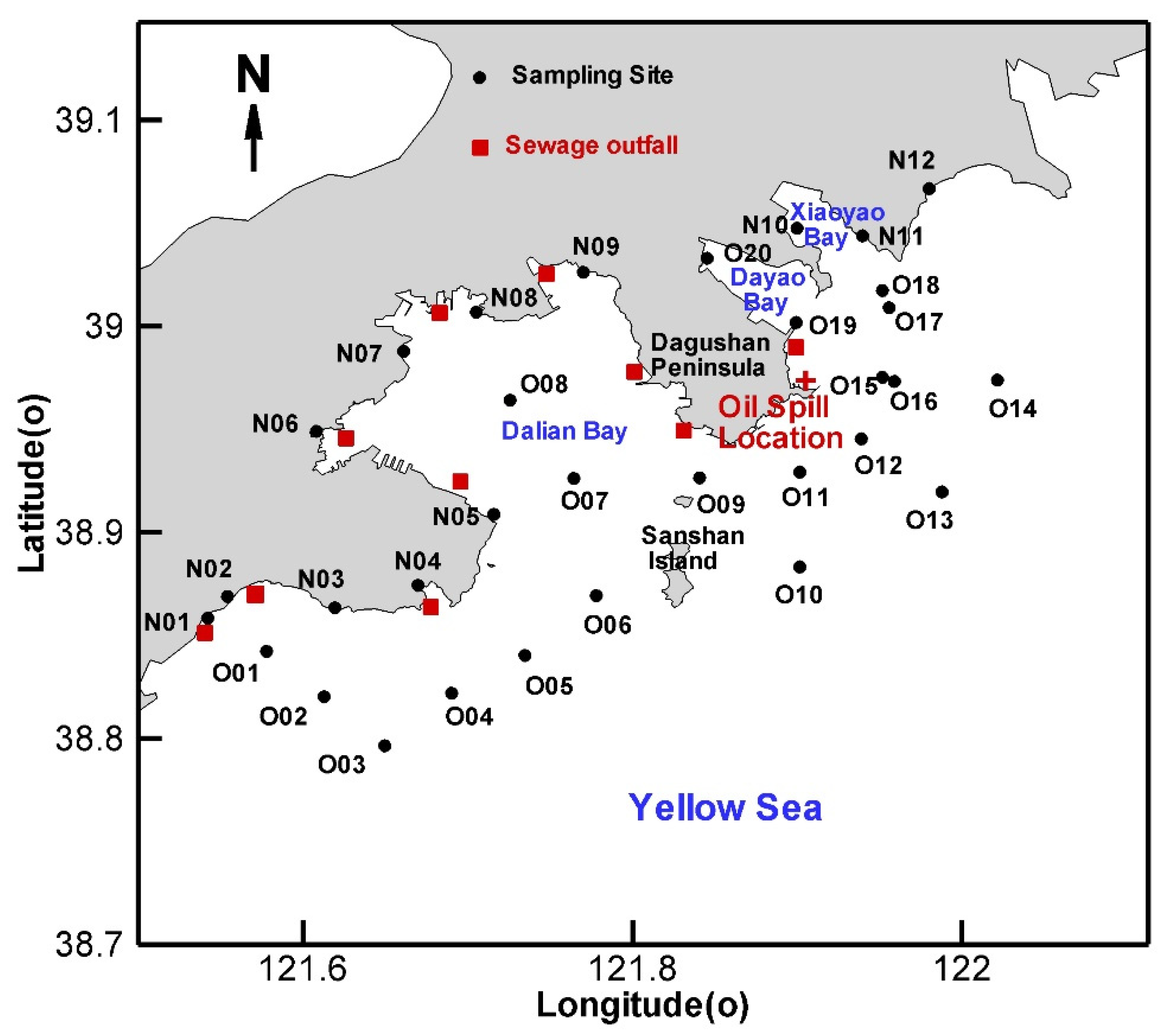
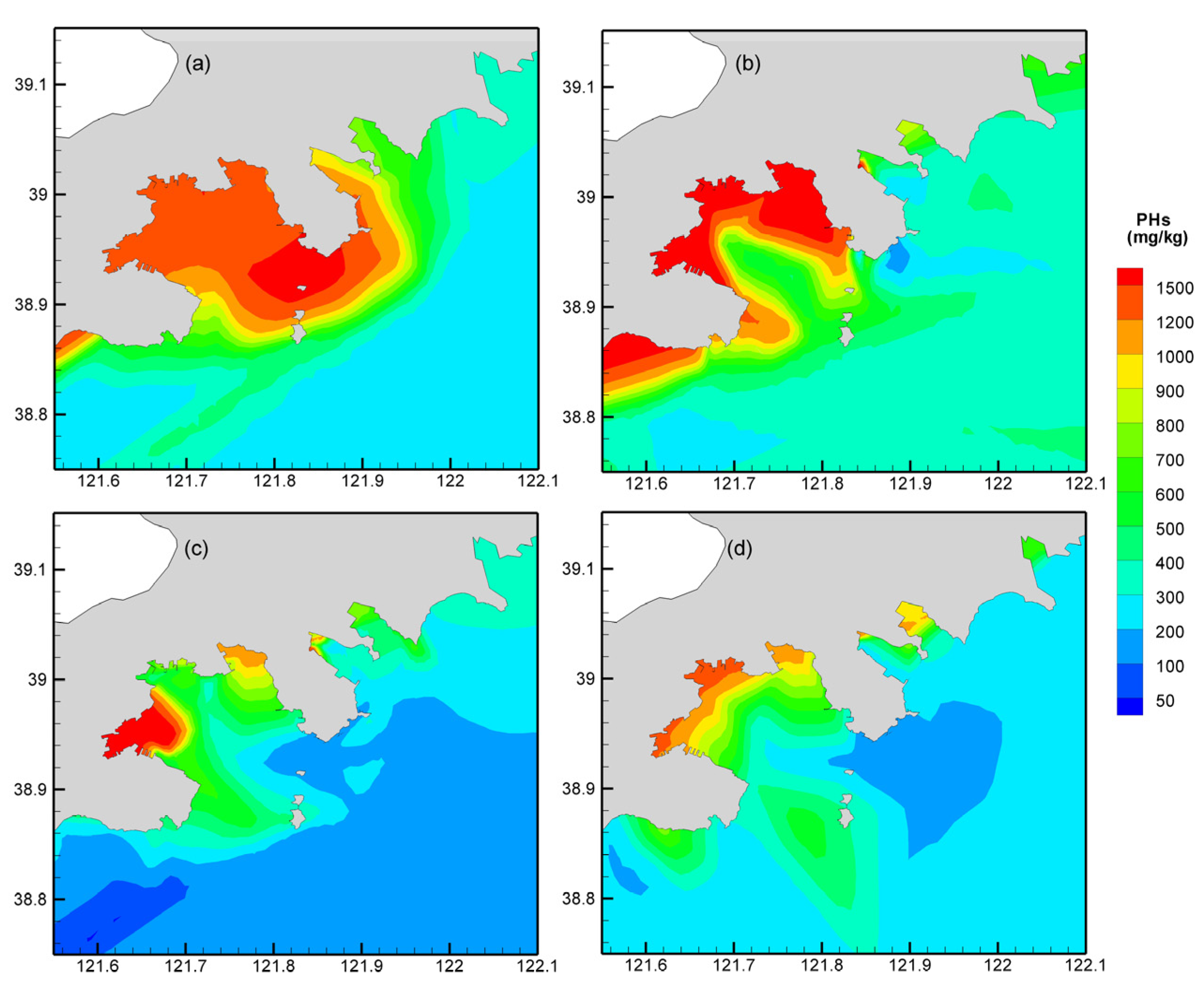
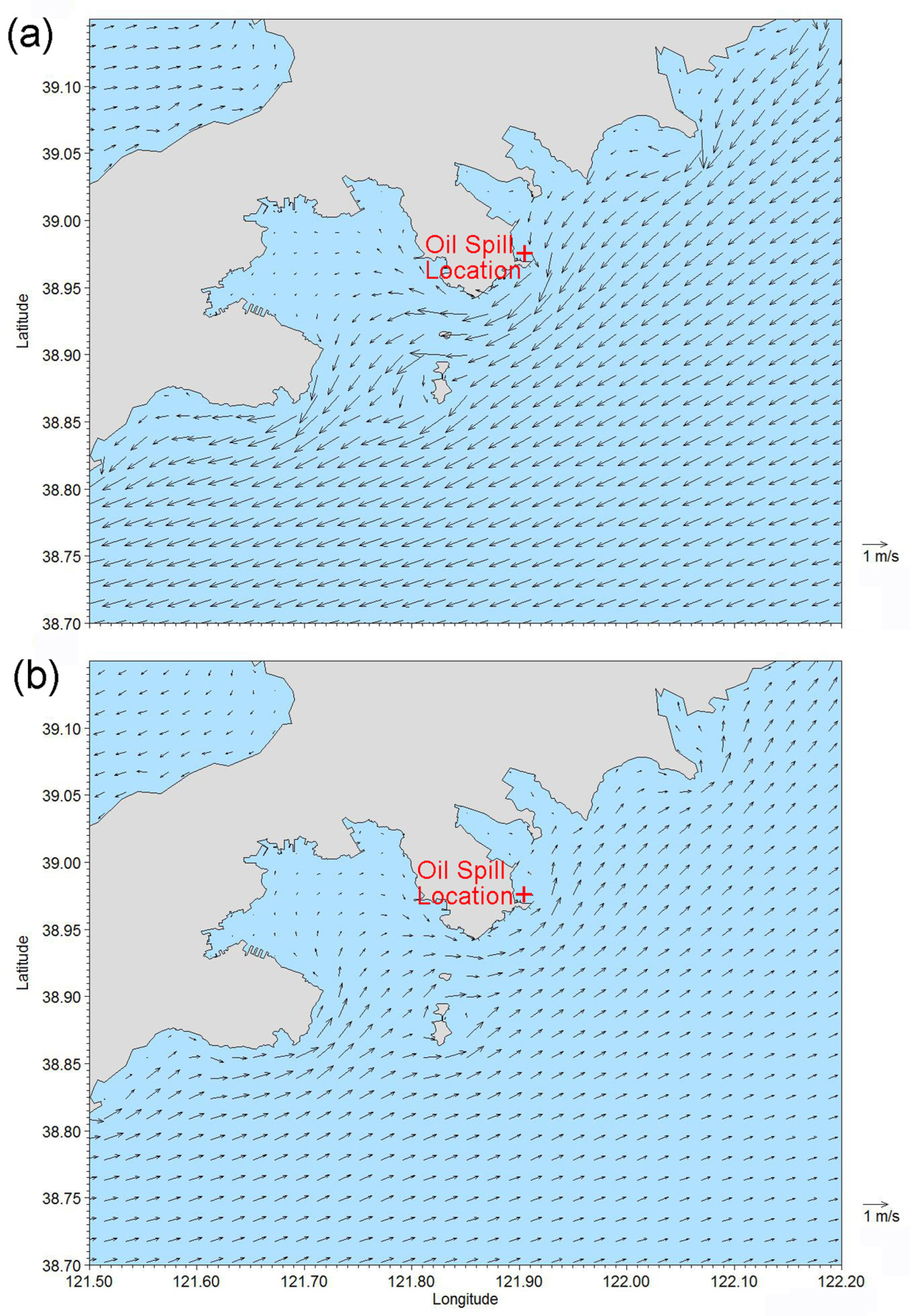
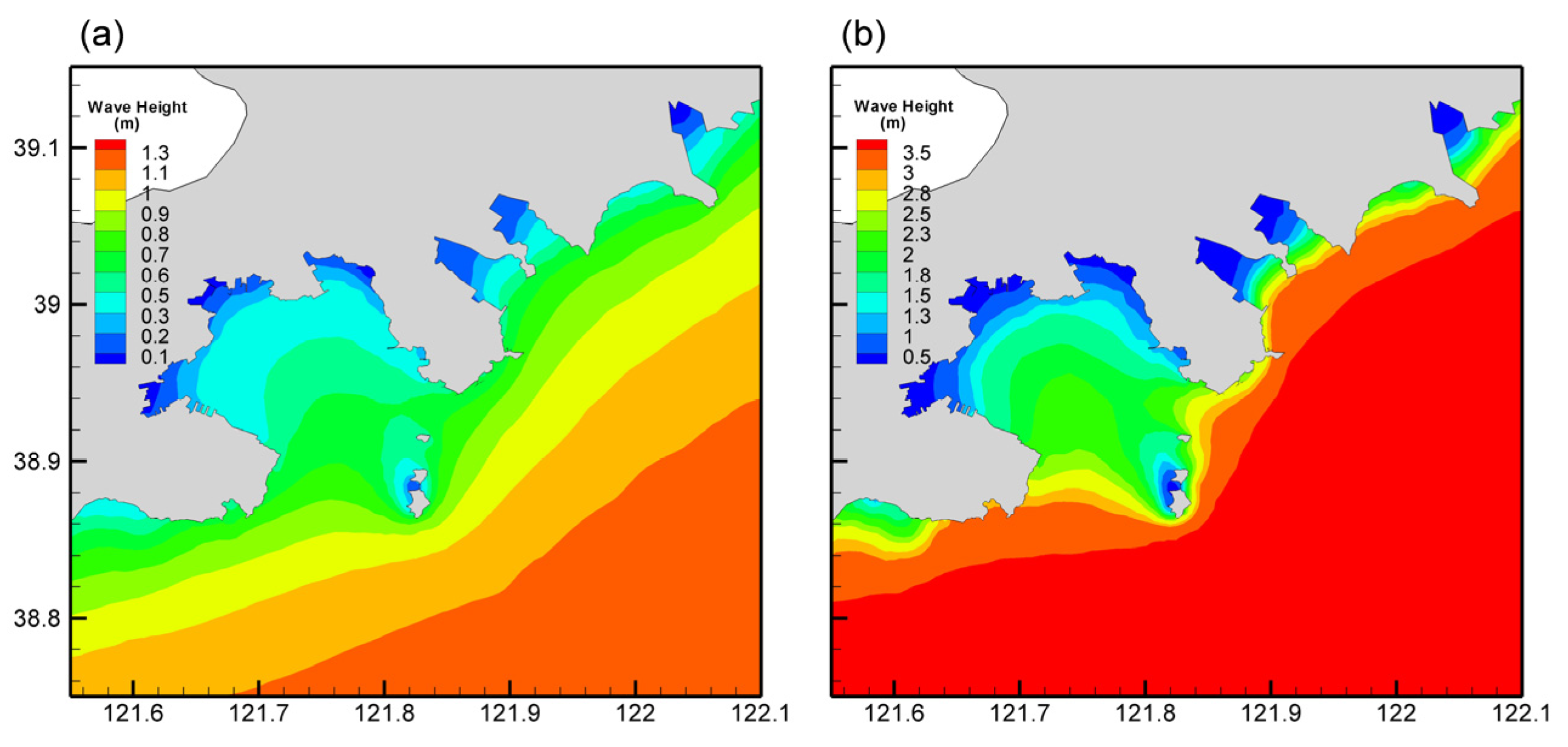
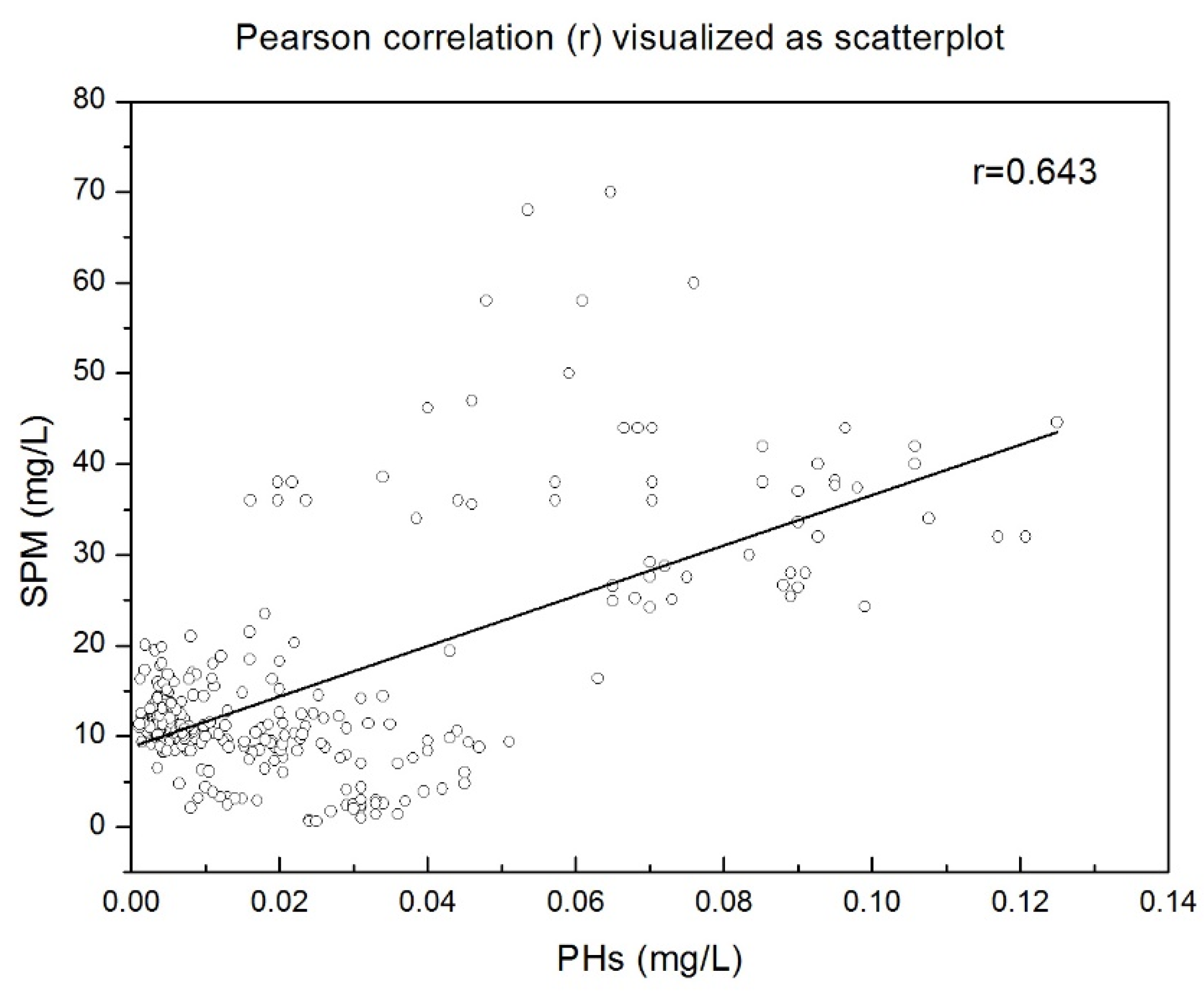
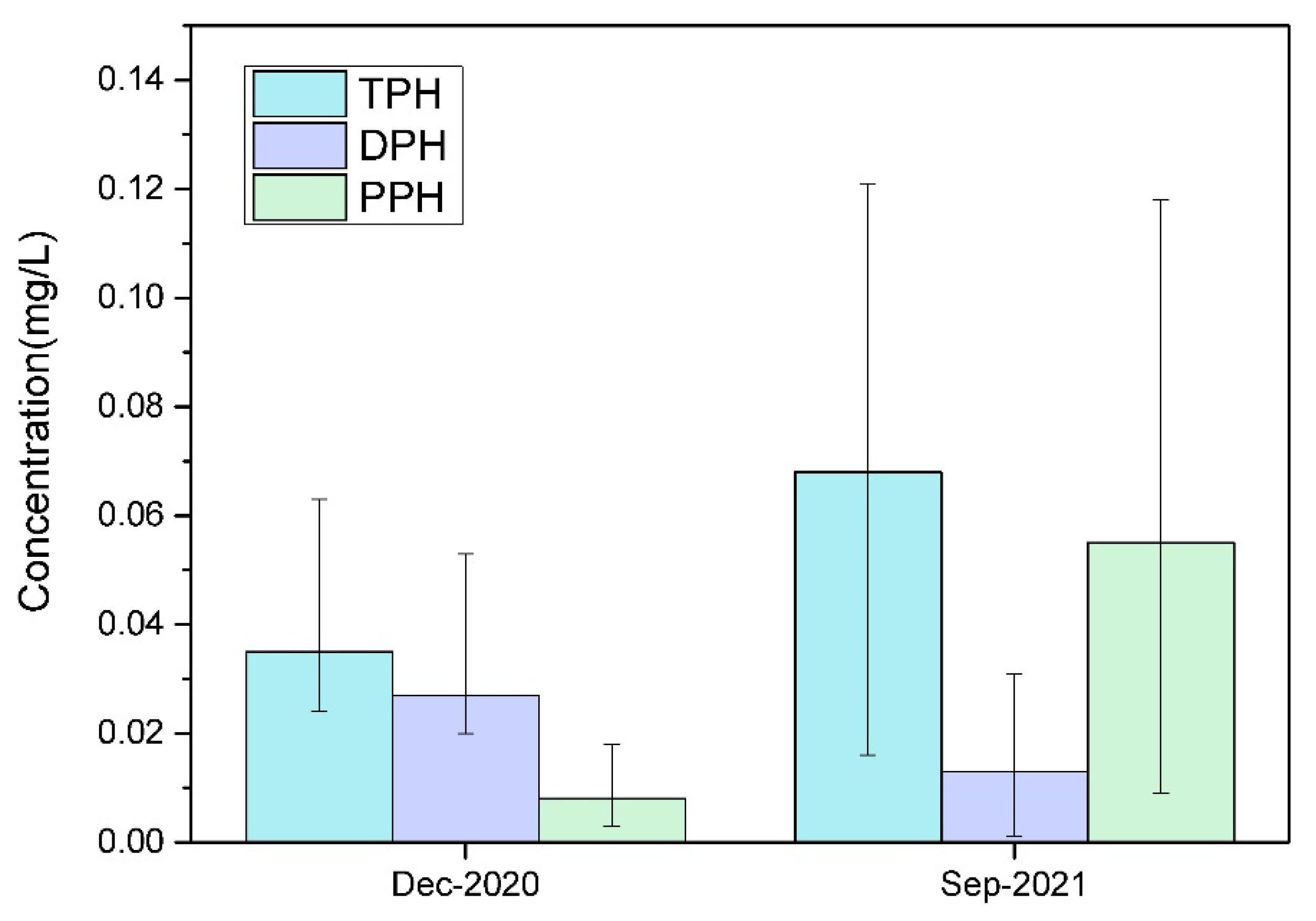


Publisher’s Note: MDPI stays neutral with regard to jurisdictional claims in published maps and institutional affiliations. |
© 2022 by the authors. Licensee MDPI, Basel, Switzerland. This article is an open access article distributed under the terms and conditions of the Creative Commons Attribution (CC BY) license (https://creativecommons.org/licenses/by/4.0/).
Share and Cite
Guo, W.; Wang, X.; Liu, S.; Kong, X.; Wang, P.; Xu, T. Long-Term Petroleum Hydrocarbons Pollution after a Coastal Oil Spill. J. Mar. Sci. Eng. 2022, 10, 1380. https://doi.org/10.3390/jmse10101380
Guo W, Wang X, Liu S, Kong X, Wang P, Xu T. Long-Term Petroleum Hydrocarbons Pollution after a Coastal Oil Spill. Journal of Marine Science and Engineering. 2022; 10(10):1380. https://doi.org/10.3390/jmse10101380
Chicago/Turabian StyleGuo, Weijun, Xinggang Wang, Sihong Liu, Xiangpeng Kong, Pengcheng Wang, and Tiaojian Xu. 2022. "Long-Term Petroleum Hydrocarbons Pollution after a Coastal Oil Spill" Journal of Marine Science and Engineering 10, no. 10: 1380. https://doi.org/10.3390/jmse10101380
APA StyleGuo, W., Wang, X., Liu, S., Kong, X., Wang, P., & Xu, T. (2022). Long-Term Petroleum Hydrocarbons Pollution after a Coastal Oil Spill. Journal of Marine Science and Engineering, 10(10), 1380. https://doi.org/10.3390/jmse10101380





